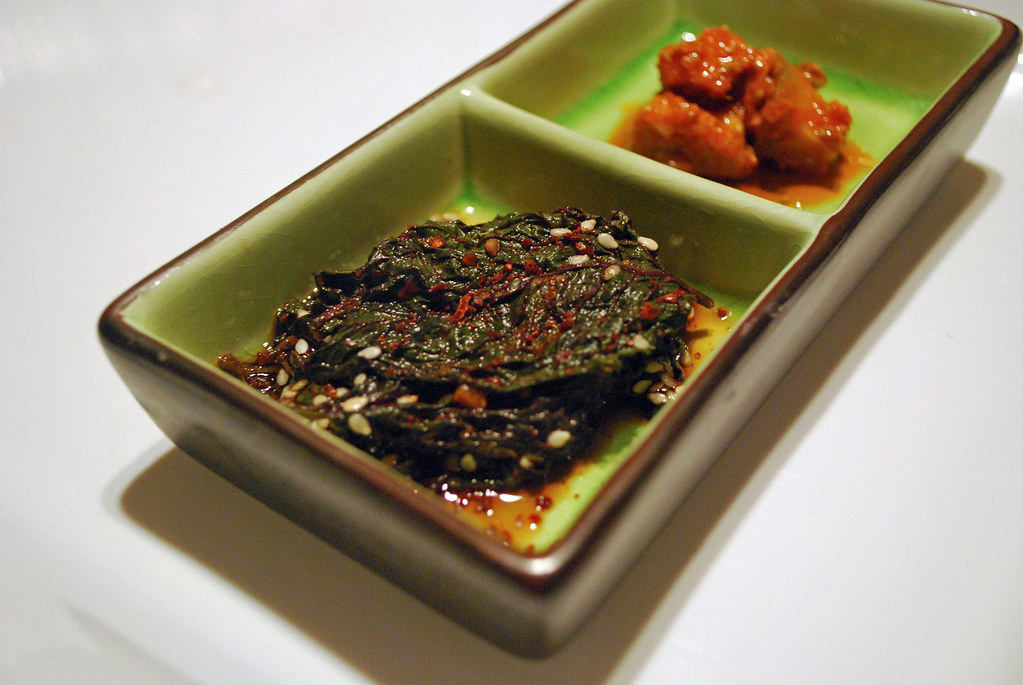Shiso in Shoyu
A couple of weeks ago, we stopped at an Asian grocery store Downtown and found a display of clear plastic bags filled with various leaves sitting in cardboard boxes. At the head of each box were signs scrawled in Chinese characters, so I wasn't able to identify what each leaf was other than by their shape and scent. I don't know my plants so I would probably eat poison ivy, left to my own devices.
Bug pointed to the bag of purple and green leaves, and exclaimed, "We need to get these!" He continued, "I think these are the leaves Seoul Garden uses for that leaf banchan," referring to the banchan of thin, uniformly stacked, firm, and roughly-textured marinated leaves with sesame. I smelled the bag. Yup, this smelled like it.
I threw the leaves in the vegetable bin in our refrigerator and there it sat, forgotten, until a Serious Eats Weekend Cook and Tell challenge was posted to "bring home a vegetable (or fruit) that you aren't familiar with."
Well, before we arrived at shiso as our vegetable, we bought kale to make chorizo kale soup. Later that morning, Bug fell down some snow-covered stairs and shattered his elbow taking Juubei out to pee. This put an end to our soup idea, since we planned on going to Mi Pueblo to shop for chorizo. Instead, we spent the whole day in the ER.
While digging around in the fridge that evening, I came across the shiso and squealed, "This would go well with the ahi we purchased earlier."
Sesame (perilla, shiso) Leaves in Soy Sauce
from Hannaone's Korean Recipes
Ingredients
4 bunches sesame leaves
1/4 c soy sauce
1/2 tsp sugar
2 cloves fresh garlic, peeled
1 tsp fine ground red chile pepper
white sesame seeds
fine ground chili pepper
Preparation
Rinse the sesame leaves well in cold water, then drain.
Crush or chop the garlic.
Cooking
Put the soy sauce, sugar, garlic, and chili pepper in a small pot and heat over medium heat until liquid just begins to boil.
Reduce heat, add sesame leaves and simmer for three to five minutes, turning often.
Remove from heat.
Use a small strainer and remove leaves from the liquid. Set strainer over the pot so that liquid drains back into the pot, and let cool.
Final Mix
Gently separate the leaves into small bunches (5 to 10 leaves).
Layer the small bunches in a sealable container, lightly sprinkling sesame seed and chili pepper over each layer. Each layer should face a different direction.
Pour the liquid over the leaves and seal the container.
Let stand at room temperature for six hours, then refrigerate.
Serve in small bunches as a side dish with Korean meals.
When we sat down to eat, I was disappointed with the leaves. They were ugly - shriveled and not firm at all. While the flavor was similar, the shoyu flavor dominated more than I preferred.
Next time I make this side dish, I am going to bind the stems together in stacks of 10 after rinsing, and blanche the leaves in the mixture, instead of cooking for several minutes. This might solve the problem of the scrunched and wimpy leaves.
Adding a water to the shoyu to thin the sauce a little will suit my tastes better. Also, allowing the leaves to sit 1-2 hours should be fine, as opposed to 6 hours, hopefully retaining the beautiful purple color and texture.
Kale would have been more of an adventure since it isn't a vegetable I was exposed to growing up, fiddling with this dish was satisfying. Also, shiso wasn't something I was exposed to much other than the dehydrated plum and leaf bits in my packet of ochazuke nori sprinkled over my rice with tea.
As for that big bush of kale, it is still sitting in the refrigerator. I'll probably take the advice given and use it as a side with mushrooms.
- Cassaendra






0 deep thoughts:
Post a Comment